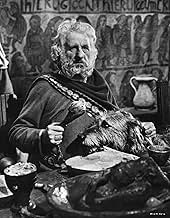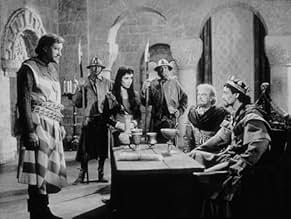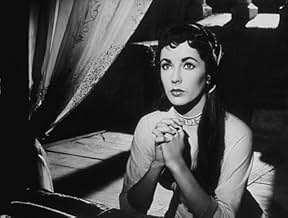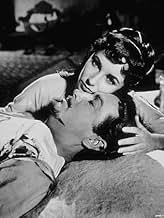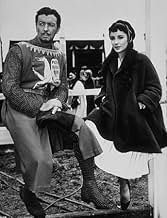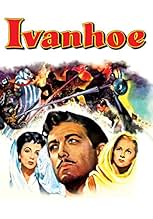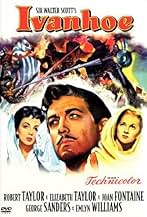De retour de croisade, Ivanhoé tente de rendre à l'Angleterre son souverain légitime car pendant l'absence du roi Richard, retenu prisonnier dans un château autrichien, son frère Jean s'est ... Tout lireDe retour de croisade, Ivanhoé tente de rendre à l'Angleterre son souverain légitime car pendant l'absence du roi Richard, retenu prisonnier dans un château autrichien, son frère Jean s'est accaparé de son trône.De retour de croisade, Ivanhoé tente de rendre à l'Angleterre son souverain légitime car pendant l'absence du roi Richard, retenu prisonnier dans un château autrichien, son frère Jean s'est accaparé de son trône.
- Réalisation
- Scénario
- Casting principal
- Nommé pour 3 Oscars
- 2 victoires et 9 nominations au total
- Front De Boeuf
- (as Francis DeWolff)
Avis à la une
This enjoyable film displays romance, chivalry, knighthood, daring jousting and lots of action with spectacular castle attack. This one proved notable hit as well as the others two Robert Taylor's forays into English history, 'Quentin Durward and Knights of the Round table', produced and directed by similar crew, Pandro S Berman and Richard Thorpe. The film packs a glamorous and luminous cinematography by Freddie Young and evocative musical score by Miklos Rozsa. The picture is excellently handled by Richard Thorpe.
The film is partially based on true events. Although Ivanhoe didn't exist, John Lackland was king of England from 1199 to 1216. Few monarchs have been subject to such appalling publicity as John, Although by no means lovable, he was an able administrator and spent more time in England than his predecessor and elder brother Richard I but he was jailed by Leopold of Austria, returning from Crusades. Besides appears Robin Hood, also known Robin O'Locksley and the Earl of Huntingdom, is probably and sadly a creation of romantic imaginations. If Robin Hood did exist, it's almost certain that he was not a Saxon , though his enemies may well have been the Norman sheriff of Nottinghan and Prince and later king John Lackland.
The praise:A big,glamorous,technicolor,adventure movie,(this is one of those films that's a movie,not a film).Suspenseful,action -packed plot has romance in terms of the jewish Rebbeca(Elizabeth Taylor),with thick jewish eyebrows,and the Lady Rowena(Joan Fontaine),a blonde.Just the right mix of perfectly staged ,suspenseful,action-packed raids,battles,jousts and trials,combined with romance,comic-relief, and Ivanhoe(Robert Taylor) himself. Miles of on location scenery.
The flaws:Too minor to quibble about.
Miklos Rosza again provides us with a major musical score. I always felt that his scores, so rich in textures, would be a prelude to his Oscar-winning score in "Ben-Hur." (1959)
The film deals with the ongoing fight between the Anglo-Saxons and Normans, the latter having ruled England since the infamous Battle of Hastings in 1066. While fighting in the crusades, Richard the Lionhearted has been kidnapped and held captive in Austria. This has been done with the help of the Austrian emperor Leopold and Prince John, Richard's evil brother, who assumes the throne in his brother's absence.
I laughed at the beginning of the film when Robert Taylor, who plays Ivanhoe, loyal to Richard, asks someone for a translation as he doesn't read Austrian. Didn't they mean German? While it is true that Germany did not become a unified country until 1871 following the Franco-Prussian war, the dialect spoken in the entire region was German.
Taylor rallies to the aid of his people. Hurt, he is given refuge by the Jewess Rebecca, played with warmth and skill by Elizabeth Taylor. Her father, Isaac the Jew, played by the always serious Felix Aylmer, promises to help pay the ransom for Richard so that his people can have religious toleration in England. Naturally, Rebecca loves Ivanhoe but so does Lady Rowena played by a much reserved Joan Fontaine. Her guardian, the father of Ivanhoe in the film, is portrayed by Finlay Currie, who played in numerous bible films.
The Technicolor and cinematography are breathtaking in the film.
A story of love and devotion, especially that of George Sanders, who sacrifices all for Rebecca.
This version of "Ivanhoe" holds up well and remains one of the more realistic films dealing with the myth, legends, and pomp of the High Middle Ages. The pictorial representation of Judaism at a time of wide-spread persecution of that religion throughout Europe by Christians who continually used the Jews as scapegoats was noble indeed for 1952, the height of the McCarthy witch hunts. The audience of the day undoubtedly overlooked this point when Rebecca is accused of witchcraft in order to insure conformity and stifle opposition to Prince John's tyrannical rule of England in King Richard's absence.
From a historical perspective, this film is about as accurate as any of the numerous Robin Hood tales prevalent at the time in the movies and on TV. Ivanhoe's father is correct when he remarks that Richard would be no better than John as far as the Saxons were concerned. Both Richard and John were ineffectual rulers. Prince John (later King John) has received a bad press as a result of the lionization of Richard the Lionheart. At least John stayed home and attempted to rule England; whereas, Richard was always traipsing about Europe and the Near East on a Crusade or leading his knights in battle mainly for personal gain. His ransom as a result of falling into the hands of the Germans was costly for his realm. Neither Richard or John was the skilled administrator their father, Henry II, proved to be, one of England's greatest monarchs. Neither inherited the diplomatic skills of their mother, Eleanor of Aquitaine, one of the great women leaders in western civilization.
The division between the Saxons and Normans as a result of the Norman invasion of 1066 is at the crux of the story, Ivanhoe being Saxon, the royal family being Norman, descended from William the Conqueror. Nothing is said about those who lived on the British Isles before either the Saxons or the Normans, the Celts first, then the conquering Romans.
A highlight of "Ivanhoe" is the jousting tournament, leading to rivalry between Ivanhoe (Robert Taylor) and Sir Brian de Bois-Guilbert (George Sanders), a rivalry that extends to winning the hand and heart of Rebecca. The alluring nineteen-year-old Elizabeth Taylor who portrays Rebecca is at the peak of her beauty and loveliness. George Sanders and Robert Taylor were much older than Elizabeth at the time. Taylor was uncomfortable making love, even on celluloid, to one so young, especially since he recalled her as a child in the early days of his movie career.
The brilliant Technicolor cinematography is bewitching even by today's standards. Adding to the eye-catching color are the action scenes, especially toward the end of the movie. The besieging of the castle is directed with élan by Richard Thorpe, who learned his trade well from directing action packed B films.
The acting is top notch throughout with Guy Rolfe as the loathsome Prince John stealing every scene he's in. The weakest is Emlyn Williams who plays Wamba (a chattel who becomes Ivanhoe's Squire). Wamba apparently is supposed to supply comic relief and is given some good lines by the writers, but Williams tends to overplay the part to the extent that at times the character becomes an obnoxious loudmouth.
Le saviez-vous
- AnecdotesAt the beginning, Sir Wilfred of Ivanhoe is looking for King Richard I by singing until he finds the King. This is historically accurate, with the exception that the singer was a minstrel called Blondel. When Leopold of Austria captured King Richard I, Blondel went around to all of the castles singing King Richard's favorite song. (One story had it that King Richard actually co-wrote the song.) When he heard King Richard join in the chorus, he went home and told the Normans where King Richard was.
- GaffesCharacters are shown eating turkey during the feast in Ivanhoe's father's hall. Turkeys are indigenous to North America and were not known in England in the 12th century.
- Citations
Minor Role: Milord, there is a stranger at your gate who begs shelter. He is a Jew who calls himself Isaac of York.
Sir Brian de Bois-Guilbert: I share no roof with an infidel.
Wamba: Why not, sir knight? For every Jew you show me who's not a Christian, l'll show you a Christian who's not a Christian.
- ConnexionsEdited into Hollywood: The Dream Factory (1972)
- Bandes originalesThe Song of Ivanhoe
(1952) (uncredited)
Music by Miklós Rózsa
Lyrics by Marguerite Roberts
Sung by Robert Taylor and Norman Wooland
Meilleurs choix
- How long is Ivanhoe?Alimenté par Alexa
Détails
- Date de sortie
- Pays d’origine
- Langue
- Aussi connu sous le nom de
- Ivanhoe
- Lieux de tournage
- MGM British Studios, Borehamwood, Hertfordshire, Angleterre, Royaume-Uni(studio: interiors and exteriors: Torquilstone Castle and lists at Ashby La Zouche)
- Société de production
- Voir plus de crédits d'entreprise sur IMDbPro
Box-office
- Budget
- 3 842 000 $US (estimé)
- Durée
- 1h 46min(106 min)
- Rapport de forme
- 1.37 : 1


